Corner toilet with cistern: pros and cons, diagram and features of installing a toilet in the corner
The parameters of bathrooms in apartments do not always have sufficient area for the standard placement of all key plumbing fixtures. The solution to this problem lies in clearly thinking through the location and choosing compact models of functional key items. One of which is a corner toilet with a cistern - an advantageous design for the original design of an adjacent bathroom.
In this article we will analyze in detail the advantages and disadvantages of such toilet models, possible installation schemes and focus on the features of their connection to communication networks. We will supplement the presented material with visual photos and useful tips on choosing a suitable toilet for installation in the corner of the bathroom.
The content of the article:
Advantages and disadvantages of corner devices
The toilet, located in the corner, has an almost identical design as in the standard version. The only difference that expresses this type of installation is the triangular shape of the drain tank. This does not affect the volume in any way.
Using Angular monoblock You can not only expand the free space in the bathroom, but also complement the interior of the room with an extraordinary model. By filling the corners with plumbing fixtures, the room takes on rounded shapes with extensive internal space.
In the Compact model, the bowl is separated from the drain tank, which is sewn into a corner niche through installation. The structure, equipped with a wall-hung toilet, is quite weighty - its load capacity is almost half a ton.
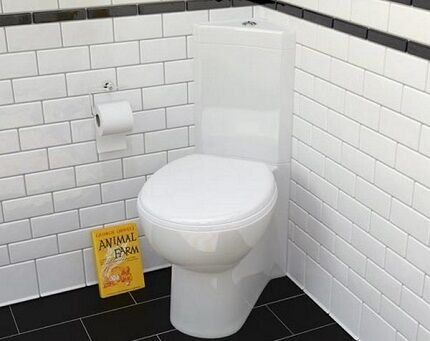
If the apartment has separate bathroom rooms, then using a corner installation in the toilet will make it possible to place additional devices, for example, a bidet. In addition to everything, the models in question can be adjusted in height up to 4 cm.
The strength of the drain container, made of solid cast material, deserves special praise. There are no leaks in it.
If for some reason the drain tank breaks or cracks appear, you don’t have to worry about the neighbors below, the risk of flooding is minimal. Thanks to the installation of an emergency system, in the event of an overflow, excess network water will be redirected to a special overflow channel.
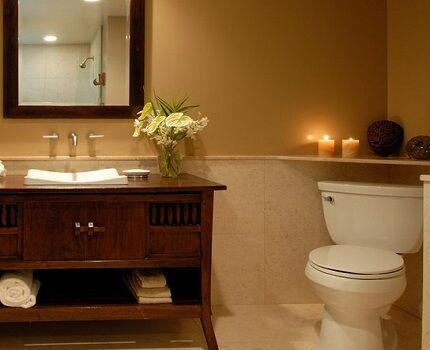
There is a slight drawback to such devices. It is associated exclusively with the method of installing mounted products.The wall on which the installation is to be installed must be strong enough to support the expected weight. And also important choose the right height during installation, taking into account the growth of all inhabitants of the house/apartment.
When it comes to plasterboard flooring, you will need to place a solid wood embedded under the sheathing in advance and fasten it with long bolts, so that both the wooden part passes through and is sufficiently recessed into the main wall.
What types of corner toilets are there?
Consumer demand for custom plumbing fixtures is trending upward. In addition to the originality of the device itself, its main characteristics are also valued: comfort and functionality.
The design of the structure also plays an important role. Apart from the shape of the cistern, visually the corner toilet is no different from the standard model, but this is not the case - there are also differences in installation.
Device manufacturing material
Despite the fact that the range of corner toilets is less extensive compared to the classics, you can still choose an interesting option.

The materials used for the production of corner sanitary models are standard.
The toilet can be made from:
- plastic;
- porcelain.
- earthenware
Thanks to modern technologies, plastic devices are made from acrylic, additionally reinforced with fiberglass and a special resin. The lightness and simplicity of the product, a high degree of strength and a non-porous structure are the main advantages of such installations.
The disadvantages include poor resistance to mechanical damage and temperature changes.
The increased degree of strength of porcelain toilets is complemented by a long service life. The basis of the production process is white clay, with the addition of natural minerals - quartz and feldspar. Glaze is traditionally used as a finishing coating.
It is this composition that makes the structure of the device less porous, and, accordingly, simplifies its care. Its main disadvantage is its high cost.
The most popular models in the affordable price category are earthenware. Plumbing fixtures made of earthenware undergo a firing procedure before the final stage of glazing.
These production processes help make the toilet durable, with high levels of protective functions, and also reduce the porosity of the material, making everyday care easier for housewives. The service life of the product reaches 15 years.
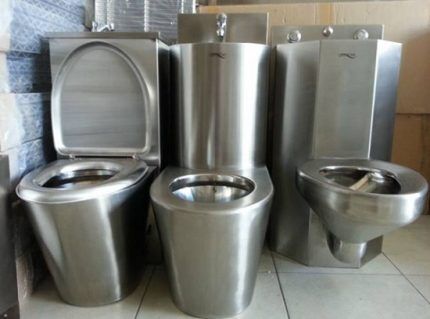
In rare cases, you can find exclusive models made of expensive materials: bronze, natural or artificial stone, steel. Due to low consumer demand for this type of product, manufacturers are in no hurry to replenish their product range.
If we take the standard version, the best products are made of porcelain. The use of high-quality materials in production with a low degree of moisture absorption allows us to create a model that does not lose its original qualities, both functional and visual, over time.
Available bowl types
Depending on what type of bowl is used in a particular corner installation, the degree of comfort during use, volume, amount of splashes during flushing and efficiency in water consumption are determined.
The market offers three options to choose from: with a shelf, funnel-shaped, with a slope of the rear or front wall.
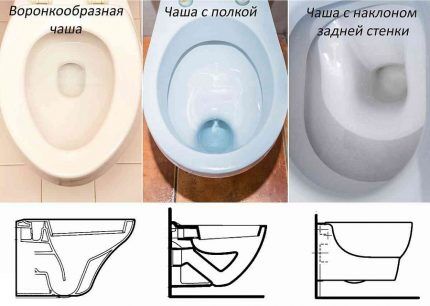
A corner toilet with a shelf has quite a lot of disadvantages. Due to the fact that all emptying products initially remain on the platform of the device, there will be a characteristic unpleasant odor in the bathroom. Also, after rinsing, you almost always need to use a brush to remove residue.
In addition, the bowl forms a water seal in which water is constantly present. But when using water of poor quality, as well as due to deposits of uric salts, plaque forms and rust may appear. And such problems must be dealt with regularly, using toilet cleaning effective means...
This type of product is also economical in water consumption. Its only advantage is that it washes off with virtually no splashing.
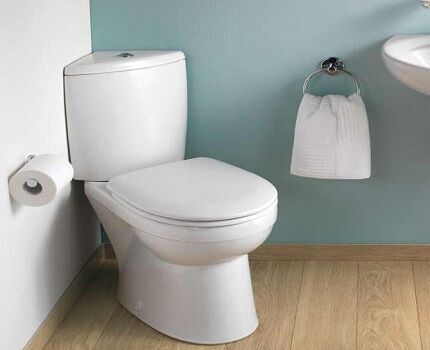
The next type of bowl has a slope of the front or rear wall, which is why the corresponding name for the plumbing fixture is sloped. Such features help to minimize the penetration of unpleasant odors.
This is all thanks to the fact that, thanks to the inclined wall, the waste goes directly into the water.Despite this, you have to use a brush almost all the time.
For a funnel-shaped device, a brush is used in rare cases. This monoblock is the most hygienic and economical, since draining does not require large amounts of water. There are practically no unpleasant odors. However, when flushing, the device produces a lot of splashes.
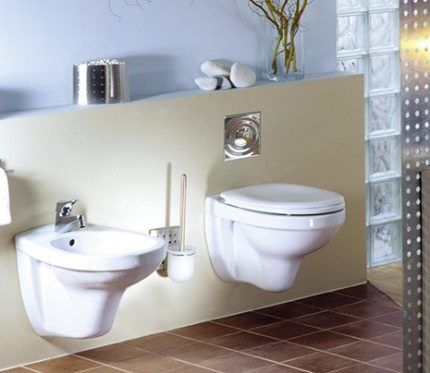
With the help of an invention called “Anti-splash”, based on adjusting the water level (the lower it is, the lower the splash level), the splashing problem was eliminated.
Bowl drainage
The direction of discharge does not affect the comfort of using the corner sanitary fixture. It is also impossible to visualize external differences, however, the choice may be influenced by the parameters and location of the sewer inlet in the bathroom.
There are the following types of bowl outlets in the toilet:
- With horizontal outlet. It is used if the socket of the sewer riser is 5-10 cm above the floor level.
- With vertical outlet. An ideal option for a bathroom where the sewer line is directed to the floor. With this arrangement, maximum space savings are achieved, however, it is rare to see such an arrangement of the sewer line in multi-story buildings.
- With oblique drain hole. The most common option, which was the first to be introduced into the markets. This model assumes a bell located at an angle or close to the floor.
It is not possible to replace a toilet with a horizontal outlet to a vertical one.This problem can only be solved if the location of the sewer pipe is changed.
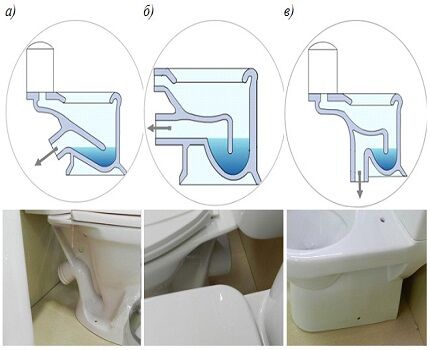
Features of connecting corner models
Next, we will analyze the installation features of toilet models that have different sewerage connections.
Installation diagram using corrugation
Non-standard models of corner products have their own characteristics, not only structural, but also expressed during the installation process. Initially, this is a suitable sewerage connection.
However, in low-rise buildings and old buildings, the riser is located along the wall, which complicates the process of installing a corner monoblock. This problem can be solved using an extension cord, which is used as corrugated pipe.
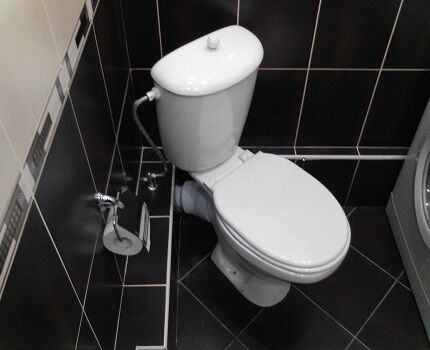
Installation begins with installing the toilet in the chosen location and outlining its boundaries. The areas where it will be necessary to drill holes for the dowels are also marked. For this purpose, there are special holes at the base of the device, on the leg. Now the drainage device must be rearranged and the gaps for the fasteners must be drilled.
Next, the toilet is placed in its original position and secured with dowels.One side of the corrugated pipe is inserted into the sewer, while the connecting section must be treated with silicone, the other is put on the outlet.
To install the drain container, you need to align the drain holes, while being careful not to move the existing silicone gasket. This seal protects the structure from leaks. Then tighten the screws.
Cold water is supplied using a flexible hose. Using sealant, the gaps between the base of the device and the floor covering are sealed. This prevents debris from getting under the toilet, making bathroom cleaning easier.
We have it on our website step by step instructions with various ways of attaching the toilet to the floor. We recommend that you familiarize yourself with them.
Now check all connections by drawing water into the drain tank and draining it.
Using an adapter to connect
Another method of connecting a toilet to a central sewer system is using pipes. Here it is worth paying special attention to the type of monoblock release.
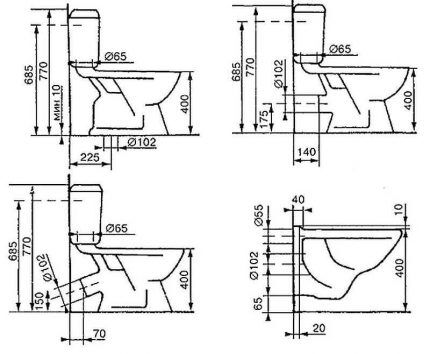
An oblique release involves installing a monoblock into the floor or wall, but in the second option fan pipe starts at an angle of 30-40°. For a vertical drain hole, the wall mounting method is used, and the location of the pipe must be at an angle of 90°.
How to install a toilet with different types of outlet?
Depending on the type of installation, there are two types of corner toilets: floor-mounted and wall-hung.In the first version, the drain mechanism is placed and mounted on the floor, in the second - on the wall.
The design of a floor-standing monoblock is more familiar and understandable. Installation of this design is not difficult and will not take much time.
With a hanging device, the situation is more complicated - here you will need a special corner installation, which is a metal frame. A sewer pipe and water supply are connected to the frame and a drain tank is installed.
The design allows you to hide the water bowl and all communications by covering them with decorative elements. The installation can be recessed into the wall or simply installed in a corner.
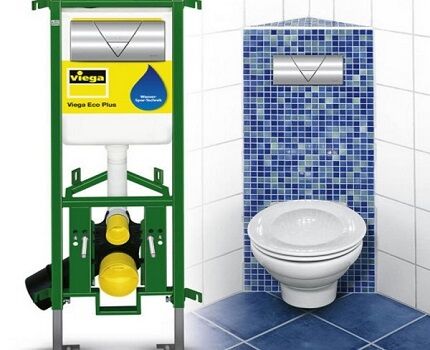
There is another type of toilet - an attached one. The product, similar to the previous one, is mounted in a corner, but its vertical axis is not placed diagonally, but parallel to the wall. Thanks to the asymmetrical offset, the drainage device can be installed close to the side wall.
Models with a bottom type of water supply to the tank are widely available on the market. Less common are devices with side feed. The option with a bottom connection is more convenient - it is almost silent when water is drawn into the drain tank.
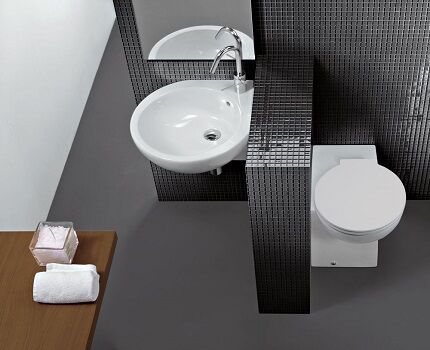
The attached type of construction, like the previous one, masks all communications either in the wall or in a special bedside table.In most cases, they are already included with the cabinet, which greatly simplifies the choice.
Instruction #1 - installation with a vertical drain
Corner models of toilets with a vertical drain hole are most often used in houses with an old layout or in private cottages.
The main positive aspects are that the working parts of the device are not visualized after installation, and the product can be placed as close as possible to the wall, since there is no need to leave space for pipe fittings.
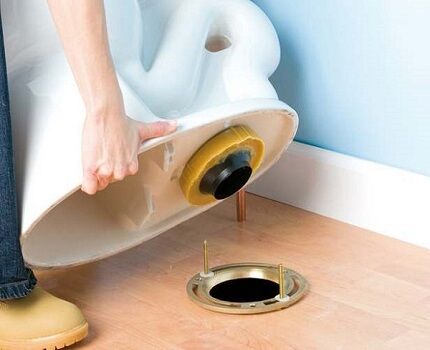
After completing the marking stage, a screw flange is installed in the hole designated for connecting the drainage system to the sewer system. All flanges are identical and have the same dimensions. Even during production, toilets with a vertical flush are equipped with parts that ensure their tight connection.
Then the monoblock returns to its place. It is necessary to ensure that all holes line up. Having installed the structure, turn it a little. At this moment, the fastening elements are tightly joined. Tightness is ensured by an o-ring located between the two parts.
Have you decided to install and connect a toilet with a vertical outlet yourself, but have never done such work? We recommend reading step-by-step installation instructions this type of toilet.
Instruction #2 - installation with horizontal outlet
If the sewer socket is located vertically, it is enough to simply connect a toilet with a horizontal type outlet to it.
The device will be located at a slight distance from the wall and riser, and the connecting elements are practically invisible due to its angular location.
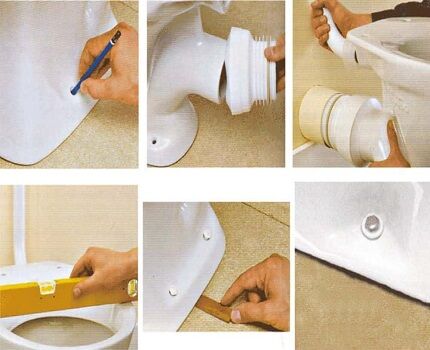
A cuff or corrugated pipe is used as a contact element for connecting a corner monoblock with a horizontal outlet to a sewer outlet.
After connection, the contacting areas of the pipes and the seal are treated with silicone. This prevents the leakage of working fluid and the penetration of waste odors.
If the center of the horizontal outlet is shifted in relation to the sewer socket, a corrugation or a set of an angle and a short pipe is used for contact. The toilet itself will be connected via a rubber cuff.
Instruction #3 - connecting a toilet with an oblique outlet
Since the mid-twentieth century, houses have been equipped with an oblique form of sewer outlet, and the pipeline itself was made of cast iron.
Now there is a need to connect the toilet drain hole with such sockets. Detailed instructions for installing a toilet with an oblique outlet is given here.
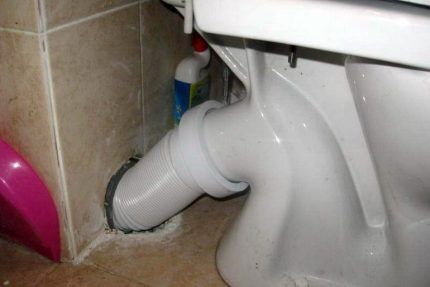
Initially, a mixture of red lead and drying oil is made in a ratio of 1:3.The composition must be constantly stirred - the red lead quickly settles to the bottom. The solution is used to treat the toilet drain hole.
After this, you need to tightly wrap the heel around the socket, with one end free. Then red lead liquid is applied a second time. Only after this the monoblock outlet is inserted into the sewer outlet.
You can use another, less dirty, method. This refers to the use of rubber cuffs. It is placed on the drain pipe and connected to the sewer pipe. If necessary, you can use the corrugation to move the toilet bowl relative to the central drain.
You can connect the drain block to a plastic drainage line using the same method as described above, with one clarification: sealing the contacts is not required.
About the installation of wall-mounted plumbing fixtures
The corner installation is installed in almost the same way as the wall-mounted model. All communication is displayed first.

Instead of a flexible water supply to the tank, it is better to use a metal pipe. For the drainage system, you can use a corrugated pipe.
The installation frame is fixed to the wall using anchors. This ensures reliable fastening and immobility of the frame structure. The bowl is located 400-500 mm from the floor level. At the final stage, the toilet is connected to the communications system.
If you have never independently installed suspended plumbing, we recommend that you familiarize yourself with more detailed installation instructions corner installation, as well as useful recommendations for selection.
Conclusions and useful video on the topic
You can learn more about the intricacies of choosing a corner toilet model from the video:
Category useful tips or how to connect a toilet and not create problems:
Nuances of installing and connecting different installation systems:
In most cases, purchasing a corner toilet is more of a necessity than a personal preference. However, this plumbing item fully justifies its purpose, and installation difficulties do not arise if you adhere to the diagram.
Are you seriously thinking about purchasing a corner toilet model and want to clarify the nuances that we missed in this article? Ask any questions you are interested in under this material - our experts and other site visitors will help you figure it out.
Or maybe you are one of the users of a corner toilet? Share your experience and a photo of your toilet model, tell us which of the disadvantages you consider significant, and which of the advantages are the most significant.




There are a lot of toilets in stores now, but I would not recommend choosing a corner option to solve space problems. In principle, a regular toilet can be placed in any apartment. But the corner one will not only be more expensive, but it will also be more difficult to maintain. After all, if you need to change the drain system in the tank, problems will arise with its selection, since not every option is suitable for a container made with bevels.
We wanted to install a porcelain corner toilet, but the prices were exorbitant, so we had to take a simple earthenware one (they didn’t even consider acrylic! The neighbors upstairs with the same layout quickly fell into disrepair!).We found only one advantage of a corner installation: it is an excellent space layout. Otherwise, the toilet is ordinary, but we still had to invest moral and material resources into the installation. If space had allowed us not to save it, we would have installed the toilet as usual.